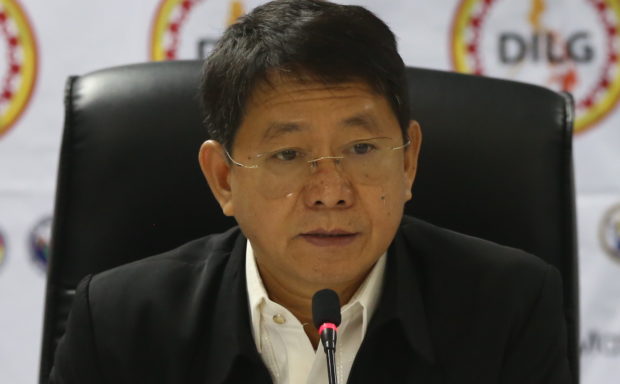
Interior Secretary Eduardo Año. (File photo by NINO JESUS ORBETA / Philippine Daily Inquirer)
MANILA, Philippines — The national government’s decision to include mayors and governors in the COVID-19 vaccine prioritization is a welcome move, Interior Secretary Eduardo Año said in a statement issued on Tuesday.
“Our governors and mayors are the heads of the local COVID-19 task forces. So it’s just right that they are prioritized since they perform a vital role in defeating the pandemic on the local level,” Año said.
“In fact, all major programs of government are implemented locally by the mayors, therefore they are critical to the success of everything that we do,” he added.
Presidential spokesperson Harry Roque announced the inclusion of mayors and governors in the A1.5 priority group in the vaccination list — just behind healthcare workers and medical frontliners — just a day earlier.
According to Roque, the Inter-Agency Task Force on Emerging Infectious Diseases (IATF) agreed through Resolution No. 115-B that the prioritization would be made “regardless of the risk classification” of the local executives’ local government units.
Prior to this, only local officials in high-risk areas were prioritized.
“In any crisis, the people always look for local chief executives, especially now during this pandemic. That’s why the DILG is fully supporting the decision of the national government to include the leaders of local governments in the A1.5 vaccination category,” Año said in Filipino.
He also noted that local chief executives would inevitably have to get out of their offices or their homes to manage the affairs of their areas, putting them at a higher risk of contracting the disease.
“They cannot serve the people just through Zoom. They need to go down to the communities and we at the DILG firmly believe that inoculating them is for the common good,” Año said.
He said the local leaders had been getting a barrage of memos from the DILG since the pandemic started to ensure that they would continue to work through the health emergency.
“Vaccinating them is not a favor but a way of making sure that the leaders would continue to serve the people,” Año said.
Most areas in the country are currently under general community quarantine (GCQ) or modified GCQ as the number of COVID-19 cases has gone down, especially in the so-called National Capital Region Plus bubble that saw a surge in cases last March.
The bubble is composed of Metro Manila, Bulacan, Cavite, Laguna, and Rizal.
At the start surge, NCR Plus was placed under an enhanced community quarantine (ECQ) and then a modified ECQ, which was further downgraded to a GCQ last May 15.
As of Tuesday, the number of active COVID-19 cases nationwide was 52,291 due to 4,487 new infections. The rise in cases was offset by the high number of recoveries, which was 6,383.
Meanwhile, the Department of Health (DOH) announced that the A1.5 subgroup would also include people working closely for the COVID-19 response, including contact tracers, social workers, and workers from urban health centers, rural health units, and barangay health stations.